Overview (the pros and cons of zoom)
Today we started with a brief brainstorm of some pros and cons of online learning in breakout rooms. I would definitely start by considering some of the unique zoom features such as closed captioning and chat that are not available in face-to-face learning. Below is the list that our group came up with, and I have bolded the ones that I think are especially relevant to me.
Positives
- You can all type at once
- No commute
- More homework and personal time
- Wearing pajamas and doing a class in bed
- Not taking the bus.
- You can multi-task a lot more things on the go
- Lectures can be recorded a lot easier, discussions are saved
- Notes are accessible online
- Ability to multitask during class.
- Less gas money
- More sleep
- Don’t have to worry about forgetting things at home
- We get to meet people’s pets!
- Closed captioning on zoom calls
- Being able to have people’s names and pronouns right there in case you forget
Negatives
- Tired bodies and eyes from too much screen time
- Lack of ability to study with/connect with classmates
- When the internet is down, no accessibility to class
- Hurts looking at a screen all-day
- I feel like I am way less active and do not get the fresh air I need
- More home distractions
- Hard to do homework after already sitting at the desk all-day
- Tech can really be a pain and not always work when you need it/want it too
- Get tired easily
- Back pain
- No resources for more hands-on classes (music, art, physical ed, tech, drama)
- Headaches (from the screen)
- Difficult to connect with profs
My experience with distributed learning
In class Michael also mentioned the situation where one learner is online or the class is a mix of in-person and online. In the class that I am volunteering with a learner was previously at-home learning and came into the classroom for this semester. What I have noticed is that the learner often lacks the resources that the other students have like handouts and other physical resources. The learner has also not had as much time to get to know their class which shows in social interactions, but the online/ home school learning seems to successfully teach them the curriculum and they are not behind academically.
Asynchronous vs Synchronous
We learned about where different activities fall on the ‘synchronous scale’ and the ‘teacher involvement scale’ using an interactive number line. (excuse the quality I was unable to get a good quality picture for some reason)

My main takeaway from this number line activity was that tech class has good variety while a lot of classes don’t, and furthermore, a lot of classes have a lot more trouble adjusting to the online zoom format.
Zoom exhaustion
This was my main connection point with today’s lesson I read an interesting article from Inc.com which covered zoom exhaustion. I think the main takeaway here is not staring at yourself. I also found this fun PBS that looked at Zoom fatigue from the perspective of a high school student. I think this video did an especially good job at determining why Zoom doesn’t fulfill our need for socialization.
My way of dealing with Zoom fatigue is by moving around when I start to get tired in class. I find that if I have a bunch of zoom calls in a row it can really lower my energy for the rest of the day unless I move around. I have also tried rolling dice to give me a simple workout or movement that can help wake me up in class but this can become a distraction. I think what I might look at in the future is a game where each different zoom cliche connects to an activity for example if we have a breakout room I have to do 10 jumping jacks or if someone starts talking while on mute I have to do 10 pushups.
